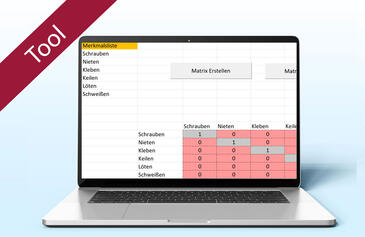
The Probability of Success Indicator tool (PSI) How to assess a project in five minutes

Every project has to be controlled. Fergus O'Connell introduces his Probability of Success Indicator (PSI). With this tool you can quickly determine how good the chances are that you will successfully complete your project.
Management Summary
Als Mitglied erhalten Sie die wichtigsten Thesen des Beitrags zusammengefasst im Management Summary!
The Probability of Success Indicator tool (PSI) How to assess a project in five minutes

Every project has to be controlled. Fergus O'Connell introduces his Probability of Success Indicator (PSI). With this tool you can quickly determine how good the chances are that you will successfully complete your project.
Management Summary
Als Mitglied erhalten Sie die wichtigsten Thesen des Beitrags zusammengefasst im Management Summary!
If you like TV hospital dramas, you will be familiar with the term, ‘vital signs’. We all know that scene where the stretcher comes through the door and the accident and emergency doctor checks for the patient’s ‘vital signs’.
There are a handful of things - especially pulse rate, temperature, respiration rate, and blood pressure - that doctors can check very quickly and which give the doctor key information about the state of the patient's essential bodily functions.
Just as people have vital signs, projects have vital signs. There are a handful of things whose presence or absence gives a project manager key information about the health of a project.
This article describes these vital signs, how to check for them and why this is a versatile tool for a project manager to have in his or her bag of tricks.
The tool is called the Probability of Success Indicator (PSI).
The Probability of Success Indicator for the vital signs of a project
The PSI is a measurement you can take at any point in a project’s life and it tells you how likely or not the project is to succeed. There are three versions of it – Simple, Intermediate and Advanced. This article describes the Simple version. First, I will describe the background of PSI and the criteria of maximum reachable scores. Afterwards, I explain how to interpret the results and give examples for uses of the PSI. At the end, you will find an example of a project’s PSI and my approach to use the results in that project.
Note: The Simple PSI measures only nine aspects of a project; the Intermediate and Advanced versions measure more than that. For example, the Advanced PSI consists of five pages of questions on many different aspects of a project. The advantage of using the Advanced PSI is that it’s a complete comprehensive assessment of a project. However, the disadvantage is the length of time it takes to gather all the answers to the questions. The beauty of the Simple PSI is that it can be calculated very quickly – literally in minutes.
In our company we have been using the PSI since we were founded in 1991. In reality, we use the Simple PSI constantly, the Intermediate hardly at all and the Advanced only when a client is looking for a very comprehensive written evaluation of a project. Normally, we use the Simple PSI and it always yields good results. If anybody needs copies of the Intermediate and Advanced PSIs, I will make them available for a free download on our website www.fastprojects.org.
Why I created the Probability of Success Indicator
The Simple PSI was born out of my experience of being involved in projects, whether as a team member (early on in my career) or later, as a project manager. It became clear to me that when projects succeeded or when they went wrong, they pretty much always did so because people had either dealt properly with (or failed to deal properly with) the same nine things – the project goal, the plan, the leader, the availability of people, contingency, risk, the project manager’s leadership style, how the project is tracked and how it is reported. Yes, there may be other factors involved but again and again these nine factors seemed to have the biggest influence on whether the project succeeded or failed.
How is the PSI measured?
The PSI is measured by rating the project against the following criteria:
|
Criterion |
Available score |
|
|
1 |
How well-defined (or not) is the goal? |
20 |
|
2 |
Is there a final, detailed list of tasks (plan) in which every task has been broken down to the 1-5-day level of detail? |
20 |
|
3 |
Does the project have somebody who, day-to-day, shepherds all of the tasks forward? |
10 |
|
4 |
Are there people to do all of the tasks identified in 2? Do those people have enough time available to devote to the project? |
10 |
|
5 |
Is there contingency in the plan? |
5 |
|
6 |
Has an up-to-date risk analysis been performed and are the jobs to reduce those risks part of the project plan? |
5 |
|
7 |
How much does the project manager vary his or her management style with the circumstances: micro-managing where necessary and hands-off in other situations? |
10 |
|
8 |
Is the project tracked on a regular basis? Never = 0; Daily = 10 |
10 |
|
9 |
Is there a weekly meaningful status reporting? |
10 |
|
Total |
100 |
Table 1: Criteria of the PSI
How to calculate the PSI
1: How well-defined (or not) is the goal?
This is a measure of how well defined the goal is. The acid test here is that if you ask each stakeholder what the goal of the project is, and if each gives you almost exactly the same reply, then the goal is well defined. Otherwise it is not. You only get a 20 when the project is complete because only then do you know exactly what was achieved. A project which is at a very early stage and where the goal has yet to be nailed down would have a low score. A project where the goal has been reasonably clarified but agreement is still needed from some of the stakeholders would get a medium score. Pick a number between 0 and 20.
Sofort weiterlesen und testen
Erster Monat kostenlos,
dann 24,99 € pro Monat
-
Know-how von über 1.000 Profis
-
Methoden für alle Aufgaben
-
Websessions mit Top-Expert:innen











At the beginning of reading…
25.09.2019
At the beginning of reading the article I was surprised about the simpleness of the questions. But I must admit after further reading it became obvious to me that the author asking the right questions keeping it simple. I do not convince anybody in this forum here how important it is to understand scope, schedule, costs incl. manpower and soft skills to control a project. This scoring model is a fast and simple approach to get an overview about the project status. Great article. Thank You.
Great Idea...
12.05.2023
... for projects with a defined goal/product in the beginning.
But i wonder if there is an adapted version for agile projects of the "PSI"? :)